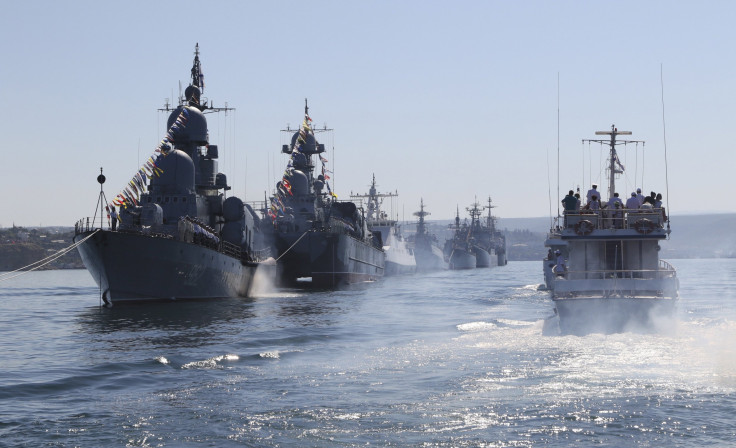'Heavily-Armed' Russian Warships Led By Cruiser Marshal Ustinov Spotted Sailing Toward UK
KEY POINTS
- Udaloy class destroyer Vice-Admiral Kulakov and a tanker Vyazma are with Marshal Ustinov
- The warships are being shadowed in the Irish Sea by a Royal Navy warship HMS Lancaster
- Marshal Ustinov took a U-Turn in between its journey, reportedly for refueling purposes
A "heavily-armed" fleet of Russian Navy ships has been spotted sailing toward the U.K, via the Irish sea. Defense analysts believe the route might take the Russian ships close to the submarine base of Faslane, home to the U.K.'s nuclear deterrent, including the Vanguard-class nuclear submarines.
According to defense analyst H.I. Sutton, the group is led by the Slava class cruiser Marshal Ustinov. The Udaloy class destroyer Vice-Admiral Kulakov and a tanker Vyazma are with Marshal Ustinov.
Though the exact positions of the cruiser and destroyer are not available, Vyazma was broadcasting its position on AIS (automated identification system), putting the group at the entrance of the English Channel en route to the Irish Sea, added Sutton in his blog post.
The group is reportedly being shadowed by a Royal Navy warship believed to be HMS Lancaster.
However, defense watchers were left confused after cruiser Marshal Ustinov took a U-Turn in between the journey towards the southwest. According to Sutton, the Russian ships reversed course for purposes of refueling and later turned back toward the Irish Sea.
***UPDATE***#Russian warships approaching UK, seemingly for a controversial passage through British territorial waters (see https://t.co/5Qss5N7g5d), are making progress.
— H I Sutton (@CovertShores) August 31, 2022
Currently doing 10 knots, this may take a while pic.twitter.com/TiHRt66fme
The cruiser reportedly left the Mediterranean on Aug. 24 after six months in the Mediterranean Sea. During its return journey through the Atlantic, two U.S. guided-missile destroyers were seen following it. These were USS Cole and USS Bainbridge, part of the Harry S. Truman Carrier Strike Group, in charge of U.S. operations in the area.
Marshal Ustinov, the sister ship of the sunken Russian guided-missile cruiser Moskva, entered the Mediterranean in early February as the head of a surface action group. It took up station off the southern coast of Crete as part of a live firing exercise in the Irish EEZ.
These ships were purportedly positioned there to defend against NATO involvement during the Ukraine invasion. They are based at Tartus in Syria, Russia's overseas base.
According to Sutton, Russia has limited facilities in the Mediterranean and cannot maintain individual vessels there indefinitely. "The Russian navy does not have meaningful maintenance facilities in the Med. We can speculate that crew fatigue from long periods of heightened readiness may be a factor in their departure," Sutton wrote in an earlier blog post.
He added that going by the route the ships took, Russia seems to be "sending a message to NATO" even during its return journey.

© Copyright IBTimes 2025. All rights reserved.





















